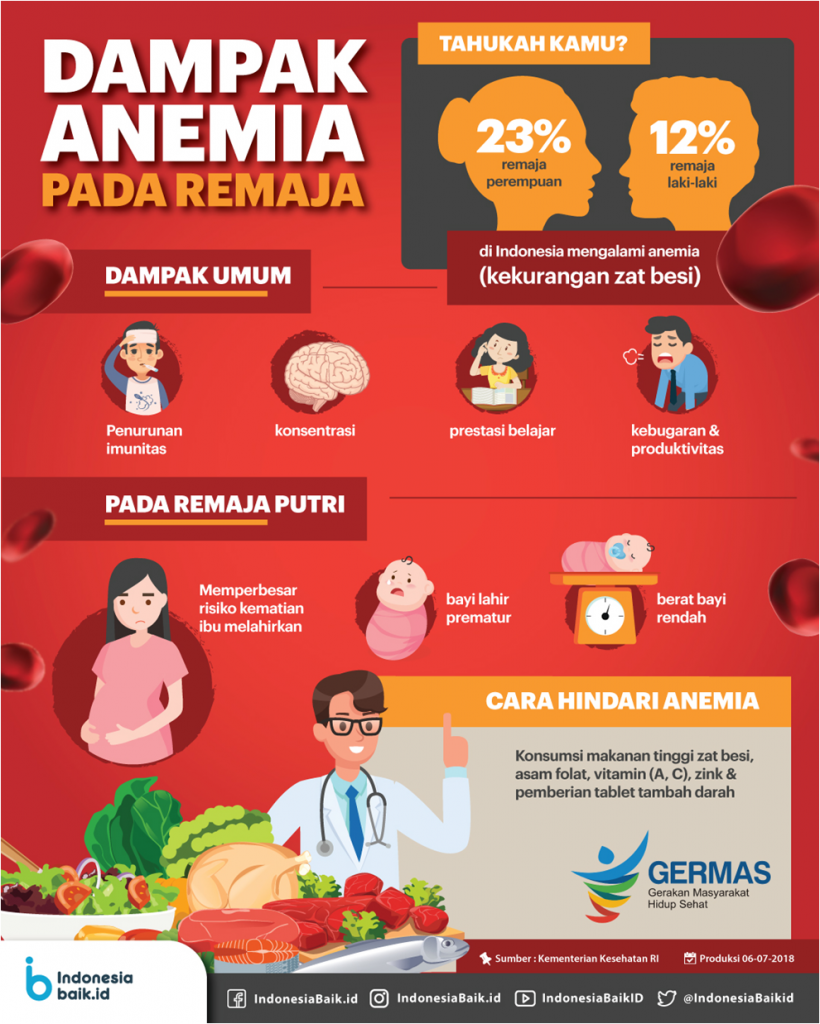
Anemia in Adolescents
Anemia is a condition where there is a lack of red blood cells in the body. Red blood cells containing hemoglobin are responsible for transporting oxygen to all body tissues. The normal value of a person's hemoglobin level is determined based on their gender and age. Normal hemoglobin levels in women range from 12-15 gr/dl, while hemoglobin levels in adult men range from 13-17 gr/dl. A person is said to be anemic if the hemoglobin level is below normal.
Causes of adolescent anemia include:
- Chronic blood loss
- Inadequate iron intake and absorption
- Increased need for iron intake for the formation of red blood cells which usually occurs during puberty.
Anemia can also be caused by other factors such as menstrual length, breakfast habits, nutritional status, mother's education, iron and protein intake not meeting needs and the presence of inhibitors of iron mineral absorption, namely tannin and oxalate.
Iron is the most abundant micro mineral in the bodies of humans and animals, namely 3 to 5 grams in the body of an adult. Inadequate iron intake means less oxygen is delivered to the tissues. As a result, people quickly feel tired, lethargic and unable to concentrate properly. Based on the 2013 AKG, the recommended iron intake for women is 26 mg/day and 15 grams/day for men.
Iron deficiency is influenced by several other factors such as non-nutritional conditions (genetic disorders, infectious diseases and worms), and nutrition because there are foods that inhibit iron absorption, such as foods that contain tannin compounds, phytate, the polysubstance besinol, oxalate and dietary fiber which found in many teas and cereals.
Apart from iron, another important nutrient in the formation of hemoglobin is protein. Protein intake will be one of the factors of anemia if protein intake is not sufficient continuously, it will affect the nutritional status of adolescents so that it can result in anemia, especially in young women.
Anemia in adolescents can have an adverse impact on adolescents, anemia that occurs can cause decreased reproductive health, motoric and mental development, hampered intelligence, decreased learning achievement, decreased fitness levels, and not achieving maximum height. Research by the Asian Development Bank (ADB) states that children who are anemic can lose their intellectual intelligence by around 6-7 points, every additional 1 g% of hemoglobin level can increase their intellectual intelligence by around 6-7 points.
To prevent anemia in teenagers, it is necessary to consume foods that play a role in the process of forming hemoglobin, namely foods high in iron, folic acid, vitamin B 12 protein, and vitamin C which functions to help absorb iron.
Contoh dari makanan tersebut antara lain :
- Foods rich in iron, folic acid and protein, such as meat, iron-fortified cereals, nuts, dark green leafy vegetables and fruit.
- Foods rich in vitamin B12, such as milk and its derivative products, as well as soybean-based foods, such as tempeh and tofu.
- Fruits rich in vitamin C, for example oranges, melons, tomatoes and strawberries. Vitamin C functions to help absorb iron.
Hindari konsumsi makanan yang mengandung zat besi tinggi bersamaan dengan makanan yang mengandung zat penghambat penyerapan zat besi seperti teh, kopi, coklat.
Hemoglobin
What is HB?
HB or Hemoglobin is a protein substance rich in iron, which is contained in red blood cells, whose function is to carry oxygen throughout the body.
What are the impacts if the body lacks HB?
HB's function is to transport oxygen and carry it to all body tissues. Without enough red blood cells, oxygen will not reach the body's organs optimally. As a result, bodily functions are disrupted. Symptoms of Hb deficiency include weakness, fatigue, lethargy, weakness, shortness of breath.
Can anemia be cured?
Anemia can be cured with several treatments tailored to the cause. If anemia is caused by iron deficiency, sufferers are advised to consume foods that play a role in the formation of hemoglobin, namely foods that contain protein, iron, zinc, folic acid, Vitamin B 12, vitamin C and can also be supplemented with Fe if necessary. .
What should Anemia sufferers not eat?
Anemia sufferers are advised not to consume foods that contain substances that inhibit iron absorption along with foods that are high in iron. Foods that contain substances that inhibit iron absorption such as phytic acid found in nuts and wheat. If you are anemic and want to consume cereals or wheat, choose cereals that have been enriched with iron. Apart from phytic acid, other substances that can inhibit the absorption of iron are tannins found in coffee, chocolate and tea.
Can drinking tea reduce HB?
Tea contains tannin, which is an anti-nutritional substance that can inhibit the absorption of iron. Iron is an important component in the formation of HB. Therefore, it is not recommended to consume tea together with foods that contain iron. If there is a lack of iron in the body, it will reduce HB production which will result in anemia.
What should we do to find out whether our HB levels are normal or not, if they are not normal, who should we consult with?
To find out HB levels, we can carry out an HB examination in the laboratory. If the Hb results are below normal, it is recommended to consult a doctor to determine appropriate therapy. The doctor will adjust Fe supplementation therapy according to the degree of anemia. Apart from that, it is recommended to consult on nutrition, for example at the RSB Nutrition clinic to get complete information about the diet that must be followed to increase HB.




